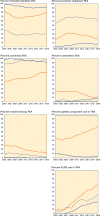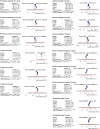The effect of patient and prosthesis factors on revision rates after total knee replacement using a multi-registry meta-analytic approach
- PMID: 35113168
- PMCID: PMC8808477
- DOI: 10.2340/17453674.2022.1997
The effect of patient and prosthesis factors on revision rates after total knee replacement using a multi-registry meta-analytic approach
Abstract
Background and purpose: Characteristics of patients receiving total knee arthroplasty (TKA) and prostheses used vary between regions and change with time. How these practice variations influence revision remains unclear. We combined registry data for better understanding of the impact of variation, which could potentially improve revision rates.
Patients and methods: We used data from 2003 to 2019 for primary TKA from arthroplasty registries of Sweden (SKAR), Australia (AOANJRR), and Kaiser Permanente (KPJRR). We included 1,072,924 TKA procedures for osteoarthritis. Factors studied included age, sex, ASA class, BMI category, prosthesis constraint, fixation, bearing mobility, patellar resurfacing, and polyethylene type. Cumulative percentage revision (CPR) was calculated using Kaplan-Meier estimates, and unadjusted Cox hazard ratios were used for comparisons. Random-effects generic inverse-variance meta-analytic methods were used to determine summary effects.
Results: We found similarities in age and sex, but between-registry differences occurred in the other 7 factors studied. Patients from Sweden had lower BMI and ASA scores compared with other registries. Use of cement fixation was similar in the SKAR and KPJRR, but there were marked differences in patellar resurfacing and posterior stabilized component use. Meta-analysis results regarding survivorship favored patients aged ≥ 65 years and minimally stabilized components. There were inconsistent results with time for sex, fixation, and bearing mobility, and no differences for the patellar resurfacing or polyethylene type comparisons.
Interpretation: Marked practice variation was found. Use of minimally stabilized and possibly also cemented and fixed bearing prostheses is supported.
Figures





Similar articles
-
Impact of patient and prosthesis characteristics on common reasons for total knee replacement revision: a registry study of 36,626 revision cases from Australia, Sweden, and USA.Acta Orthop. 2022 Jul 5;93:623-633. doi: 10.2340/17453674.2022.3512. Acta Orthop. 2022. PMID: 35819795 Free PMC article.
-
What Can We Learn From Surgeons Who Perform THA and TKA and Have the Lowest Revision Rates? A Study from the Australian Orthopaedic Association National Joint Replacement Registry.Clin Orthop Relat Res. 2022 Mar 1;480(3):464-481. doi: 10.1097/CORR.0000000000002007. Clin Orthop Relat Res. 2022. PMID: 34677162 Free PMC article.
-
Decreased Survival of Medial Pivot Designs Compared with Cruciate-retaining Designs in TKA Without Patellar Resurfacing.Clin Orthop Relat Res. 2020 Jun;478(6):1207-1218. doi: 10.1097/CORR.0000000000001120. Clin Orthop Relat Res. 2020. PMID: 31977446 Free PMC article.
-
Comparison of revision rates and epidemiological data of a single total knee arthroplasty system of different designs (cruciate retaining, posterior stabilized, mobile bearing, and fixed bearing): a meta-analysis and systematic review of clinical trials and national arthroplasty registries.Arch Orthop Trauma Surg. 2024 May;144(5):1997-2006. doi: 10.1007/s00402-024-05286-6. Epub 2024 Apr 3. Arch Orthop Trauma Surg. 2024. PMID: 38570357 Free PMC article.
-
Evaluation of the Medial Stabilized Knee Design Using Data From National Joint Registries and Current Literature.J Arthroplasty. 2020 Jul;35(7):1950-1955. doi: 10.1016/j.arth.2020.02.026. Epub 2020 Feb 18. J Arthroplasty. 2020. PMID: 32224003
Cited by
-
Impact of patient and prosthesis characteristics on common reasons for total knee replacement revision: a registry study of 36,626 revision cases from Australia, Sweden, and USA.Acta Orthop. 2022 Jul 5;93:623-633. doi: 10.2340/17453674.2022.3512. Acta Orthop. 2022. PMID: 35819795 Free PMC article.
-
Analysis of gender differences with traditional posterior stabilized versus kinematic designs in total knee arthroplasty.Arch Orthop Trauma Surg. 2023 Dec;143(12):7153-7158. doi: 10.1007/s00402-023-05008-4. Epub 2023 Aug 8. Arch Orthop Trauma Surg. 2023. PMID: 37552326 Free PMC article.
References
-
- SKAR.. Swedish Knee Arthroplasty Register Annual Report 2020 Lund University: Lund, Sweden; 2020. Available from https://www.myknee.se/pdf/SVK_2020_Eng_1.0.pdf (retrieved June 10, 2021).
-
- AOANJRR.. AOANJRR Hip, Knee and Shoulder Arthroplasty: 2020 Annual Report Adelaide: AOA; 2020. Available from https://aoanjrr.sahmri.com/annual-reports-2020 (retrieved June 15, 2021).
-
- NJR.. National Joint Registry 17th Annual Report; 2020. Available from https://reports.njrcentre.org.uk/Portals/0/PDFdownloads/NJR%2017th%20Ann... (retrieved June 15, 2021). - PubMed
-
- Price A J, Alvand A, Troelsen A, Katz J N, Hooper G, Gray A, et al. . Knee replacement. Lancet 2018; 392(10158): 1672-82. - PubMed
Publication types
MeSH terms
Substances
LinkOut - more resources
Full Text Sources
Medical

